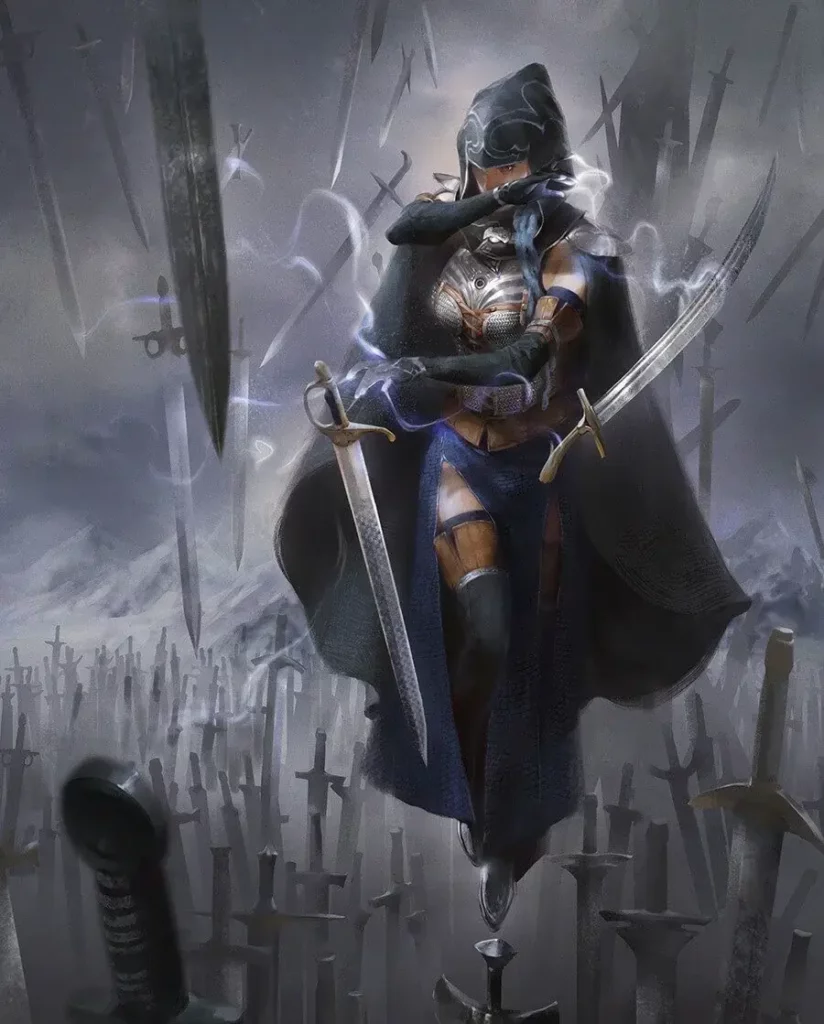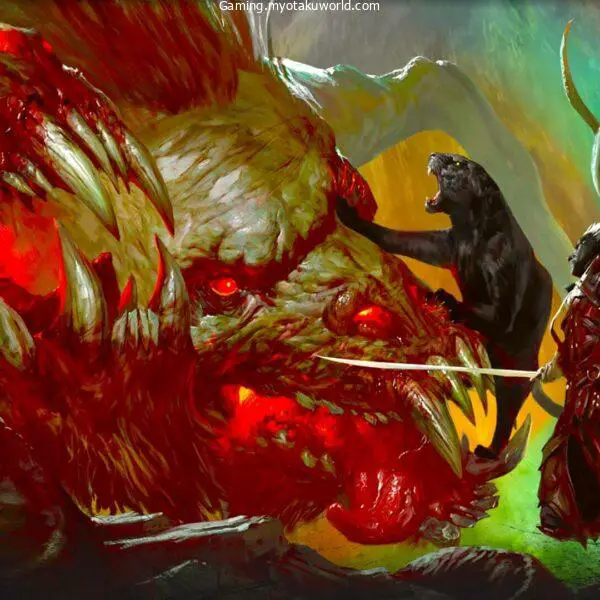The Tomb of Horrors is up ahead. The next level and your goal are at the end of a dangerous road. Time is very important. You need to move quickly before the curse eats up the whole island.
You believe the people in your group, and you can talk to each other very well. Your only problem is the savage, who always causes more trouble than he needs to.
You move forward and enter the tomb’s first path. A long, strange hallway that looks like it got lost in time. You all know that the basement is full of dangerous traps, so you ask the rogue to get rid of them. He looks around and then gets to work on his tools for stealing.
Everything was going well until the savage yelled, “This is taking too long!” and ran ahead. You tried to stop that idiot, but it was already too late.
The room shook, and you were scared as bullets, spears, darts, fire, and other things rained down on the barbarian.
Damage was also done to the rest of the group. In the end, the savage stood proudly at the back of the hall and looked at you and the rest. “Mmh, it wasn’t really that bad,” he said with a smile.
After saving a lot of people, the group that was almost killed starts to take a break while they tie up the warrior.
Thank you, Ilmater. You knew something like this was going to happen, so you gave everyone just the right amount of strength.
Welcome to an Aid 5e Guide.
Is Aid a good spell?
Aid is a strong buff that is easy to use and has a wide range of uses. This abjuration power is almost a must-have if you want to be a supporter in the group. The Help spell has long-lasting benefits and almost no bad side effects.
If the party gets this power, it will help both the tanks and the glass cannons do better. Now, let me explain why Aid is a great spell that doesn’t get enough attention.
What is “Aid?”
Aid is a 2nd-level abjuration spell, according to the Player’s Handbook. It takes 1 action to cast, has a range of 30 feet, and lasts for 8 hours. There are three parts: verbal, physical, and material. Here’s how the effect looks:
“Your spell makes your friends stronger and more determined. Pick up to three animals that are nearby. The maximum and current hit points of each target go up by 5 for the time.”
The spell gives an extra 5 hit points for every spell spot after the second.
Breaking down the spell’s characteristics
Aid is a 2nd level spell, so it will be used early in the game when most characters don’t have more than 20 HP. It has to fight with spells like Barkskin, Lesser Restoration, Enhance Ability, Enlarge/Reduce, Healing Spirit, and more. But the magic is still useful throughout the game.
It’s a spell to get rid of someone. This school’s magic tends to protect, stop, or get rid of other people. Its main focus is on defense. When it comes to Aid, the magic school is a great fit. Because the magic is so easy, it’s hard to say that it should be used somewhere else.
The time it takes to cast a move is usually the same. Even so, the spell is usually better cast outside of battle, so the time it takes to cast is less important. Still, the spell can be used in fight in some ways. Still, they have more to do with not being ready than with being useful in battle.
It has just enough range to let you cast it in a room with everyone in your party. Having 30 ft is a way to give the spellcaster an advantage in battle so they can use the spell without putting themselves in danger. This range is one of the reasons I like Healing Word better than Cure Wounds at first level, so keep it in mind.
The length is long enough to last a whole day of exploring. You might need to cast it more than once in a single day if the duration ran out, if it was dispelled, or if the party needs healing in the middle of a fight and you have no other choices.
If an adventure day usually lasts longer than eight hours, it’s best to find the right time to cast it, not just at the start of the day. These moments could be anything from the time before you go into a dungeon to the first few seconds before a fight.
Aid is made up of all three parts. Most of the time, these limits wouldn’t matter because the spell is mostly used outside of battle. So, know that you can’t cast it if you can’t talk, if both your hands are tied, or if you don’t have the material component or spell focus.
Breaking down the spell’s effect
Aid is a simple spell with a short description. However, it is essential to analyze the specific wording of the spell and what things it leaves out.
Choose three targets
When you target a creature, you need a line of sight for that creature. Therefore, even if your ally is within the spell’s range, it can’t be behind total cover. You can’t cast this if you’re blinded.
Now for the number of targets, I must say that the spell falls short, but with a good reason. The spell is essentially 15 HP divided between three creatures, and more targets would mean more total HP.
Compare this to the new Healing Spirit, which can heal on average 10.5 HP depending on the caster’s ability modifier. The downside is that for most parties, three targets won’t be enough to cover all members.
No Concentration

This is one of the spell’s most important parts. When a spell lasts a long time, it’s important to think about the Concentration requirement.
We can now combine this magic with others that don’t need Concentration. We can also cast this spell more than once to cover the whole group if there are more than three people in it.
Does that mean that I can use this spell on the same target more than once? I’m sorry, but no. “The effects of the same spell cast more than once don’t add up,” the PHB says about how to cast spells. Which makes a lot of sense. If it’s possible, we could fix the broken HP of the party.
Hitpoints maximum increase
In DND, there are two kinds of Hitpoints: normal Hitpoints (HP) and temporary Hitpoints (THP). People often think that this spell gets you 5 more THP. But that’s not the case. The spell raises the most HP you can have, which is different for two reasons:
- Temporary Hitpoints can’t be healed. This is important because this spell gives you HP that can be recovered further down the adventure.
- Temporary Hitpoints don’t stack. Combining this with all the rest makes this spell able to mix with many other effects that bring the life pool of a character really high.
Everyone has felt once in this game the terrifying sensation of ending a fight with just 1 HP left. Five extra HP may not seem much, but it can make the difference.
Current Hitpoints increase
The part of the spell that says it gives you 5 current HP is meant to be used outside of battle to make a creature’s total health 5 HP higher. But sometimes this spell is used to heal, since that’s what it’s really about.
Still, “increasing your current HP” is not the same as “regaining” or “restoring” HP. On Twitter, Jeremy Crawford said, “Disciple of Life doesn’t help the help spell. The spell raises your max health. It doesn’t bring back health.” From this, we can figure out that raising your “current HP” is not the same as restoring them.
Because of this confusion, the spell is often used wrongly to wake up friends who are asleep. If we go through each rule and run it as written, we find something strange: When a friend of yours has no health left, it starts making Death Saves. The rules say that these saves only happen if the monster “begins its turn with 0 Hitpoints.”
So, if you cast Aid on a friend who was making a Death Save, they would stop making those saves. But the unconsciousness stops if “you regain any Hitpoints.” So, after you cast the spell, your friend would still be asleep and have 5 HP. They wouldn’t wake up unless they were fixed by an effect that “regains” HP.
I have to say that this is a bit of a bug, but both the spell’s purpose and the way the rules are written lead to this strange place. The DM can always make a different decision and use their best judgment. I like the decision, even if it is somewhat nonsense.
This is because if the spell brought downed friends back to life, it would be better than the 3rd level “Mass Healing Word,” but if it didn’t work, it would be weaker and less reliable. I like to think of the spell in those situations as giving the fallen ally a little more will to live.
Add this line to the end of the spell: “If the spell is cast on an ally with 0 HP, that ally will stabilize and regain consciousness the next turn with 5 HP.”
Upcast potential
Most spells in the game aren’t very good when cast at higher levels. It makes sense, since the higher the level of a power, the better it should be. Still, bigger spell slots can sometimes be used to cast spells that have a high chance of working.
For every spell spot above the second, Aid gets 15 more HP to share between three people. If you cast it at level 5, for example, your party would get an extra 60 HP. That’s enough to stand up to all of a Hydra’s bites!
Who can “Aid” their allies?
Character options

Aid is a second-level spell in the spell lists for Artificer, Cleric, and Paladin. Clerics are full-casters, which means they will be able to learn the spell at 3rd level. On the other hand, Artificers and Paladins could use the magic at the 5th level, which was much later in the game.
Also, full casters can use higher-level spells and have more spots. Also, Peace Domain Clerics always have this power ready to go.
You could catch this spell in other ways besides going straight to those spell lists. Right now, the Divine Soul Sorcerer’s Divine Magic and the Bard’s Magical Secrets are the only two ways to get Aid. The first group has to add it to their list of spells, and the second group has to get ready for it at the start of the adventure day.
Clerics have the best chance of getting the power they want. It’s great that they can choose their spells at the start of the day instead of being stuck with them when they level up. Help is nice, but it’s best to save it for when the fun day is going to be dangerous.
So, the Divine Soul Sorcerer and their metamagic are the other candidate. Using Extended Spell to make Aid last longer is a good way to save spell slots, and giving a magician a way to heal is a good trick.
DM options
Right now, there are no creatures in any of the official books of DND with Aid. The spell is excellent, but the extra 5 HP count on many creatures can be an unnecessary burden on the already full plate of the DM.
Besides, the DM can change the life of creatures before the fight if the average seems too low. This makes Aid not a very good spell for DMs in general.
However, ally NPCs with Aid are an excellent implementation for DMs. Tracking those HP can be confusing for monsters, but PCs follow their own HP.
Furthermore, this is a good way of granting the party a prize for doing something good, like saving a Paladin from a dungeon. It can also be a paid service some Clerics do for coins.
FAQs
Can I cast Aid on objects?
No, the spell specifies that the targets are “creatures.”
DOES AID GIVE TEMPORARY HIT POINTS?
No, aid bumps your hitpoint maximum. They are two distinct pools of hp.
CAN I HAVE AID CAST MULTIPLE TIMES IN ITS DURATION?
Yes. Aid doesn’t require concentration, so you can have multiple castings of it simultaneously. So you can cast it over those npcs you need to protect.
CAN I STACK AID WITH HEROES FEAST?
Yes. Every effect that grants a bonus to your hp maximum can be indefinitely stacked unless stated otherwise. This also applies to things like hill dwarfs’ dwarven toughness.









